Abstract
The significance of microsomal vitamin E in protecting against the free-radical process of lipid peroxidation was evaluated with the low-level-chemiluminescence technique in microsomal fractions from vitamin E-deficient and control rats. The induction period that normally precedes the ascorbate/ADP/Fe3+-induced lipid peroxidation was taken as reflecting the microsomal vitamin E content and was found to be 5-6-fold decreased in microsomal fractions from vitamin E-deficient rats. Supplementation of microsomal fractions from vitamin E-deficient rats with exogenous vitamin E partially restores the induction period observed in that from control rats. The decrease in chemiluminescence intensity and the increase in the induction period both correlate linearly with the amount of vitamin E added. However, the efficiency of exogenous vitamin E is about 50-fold lower than that exerted by the naturally occurring vitamin E in microsomal membranes. These observations are discussed in terms of the process of re-incorporation of vitamin E into membranes, the experimental model for lipid peroxidation selected, and the method to evaluate lipid peroxidation, namely low-level chemiluminescence.
Full text
PDF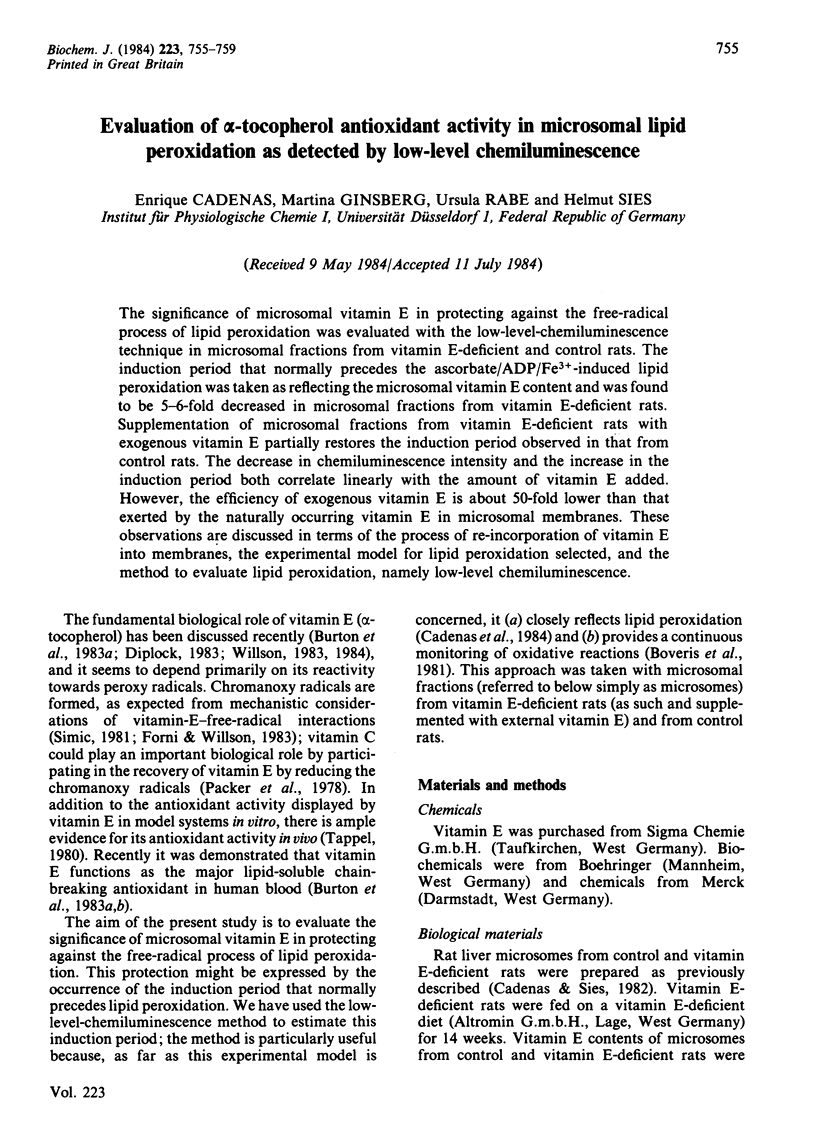
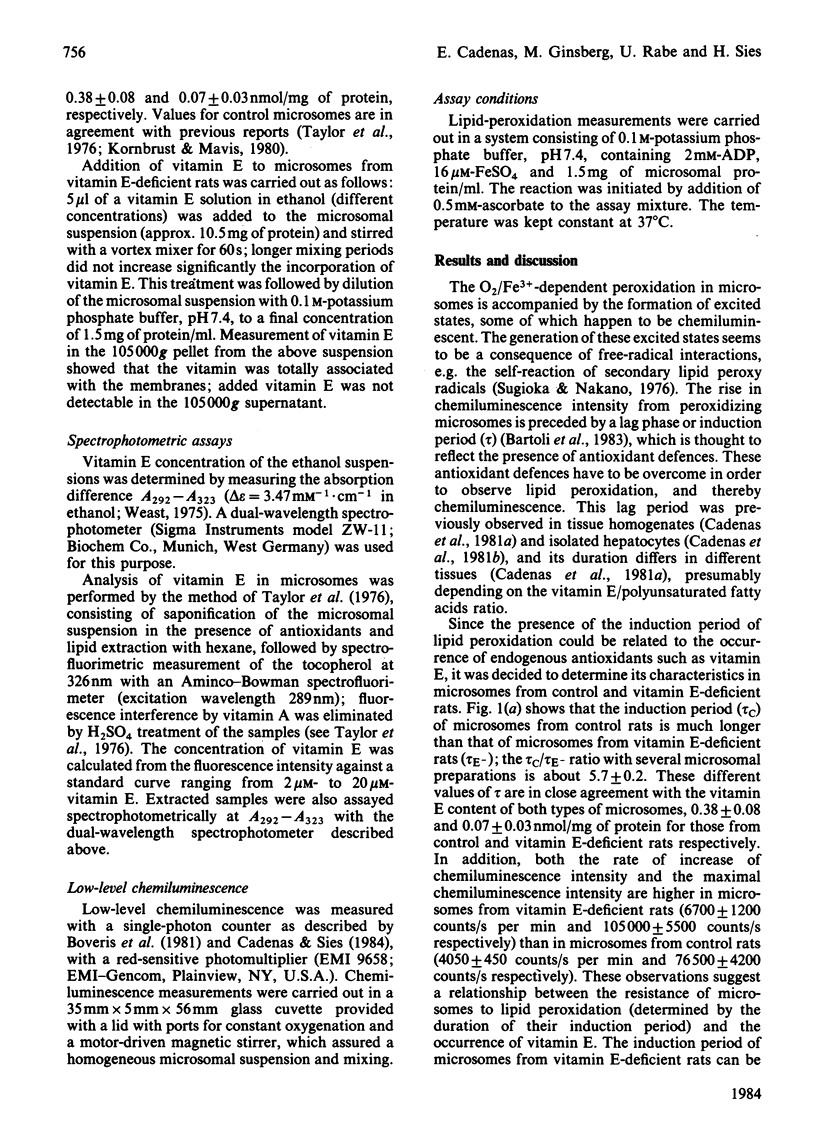
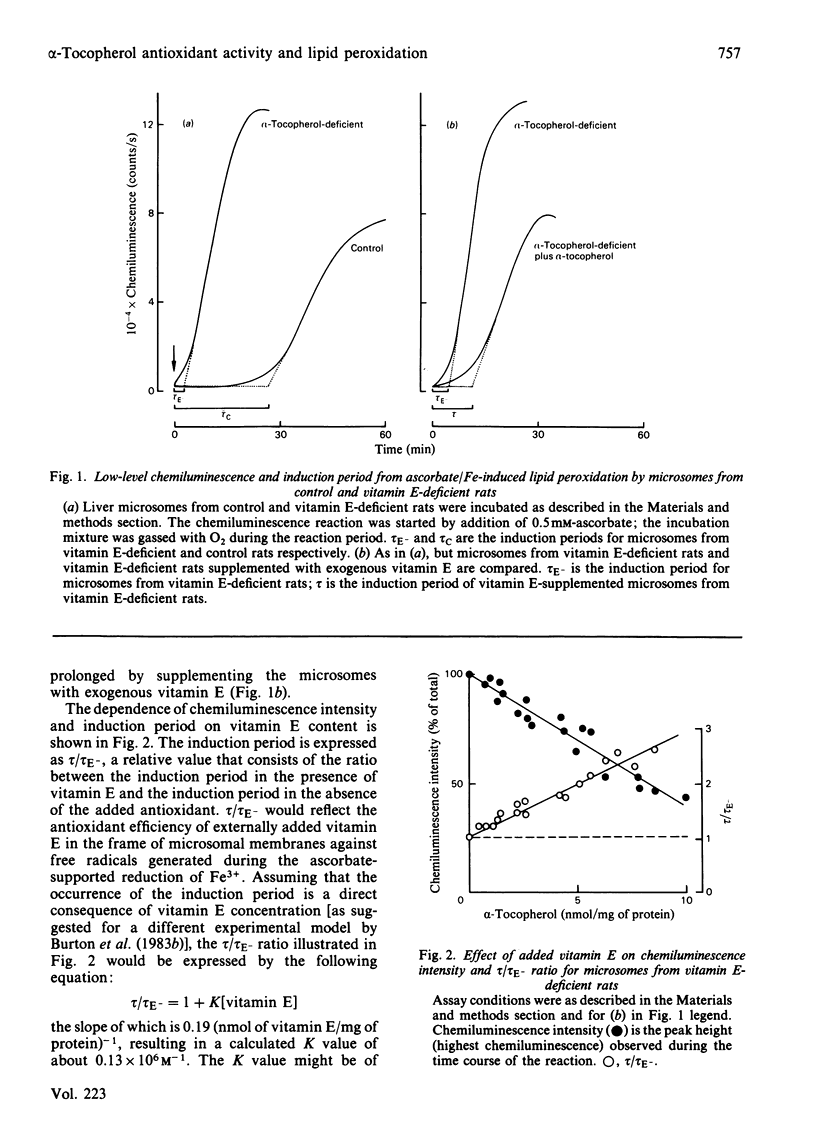
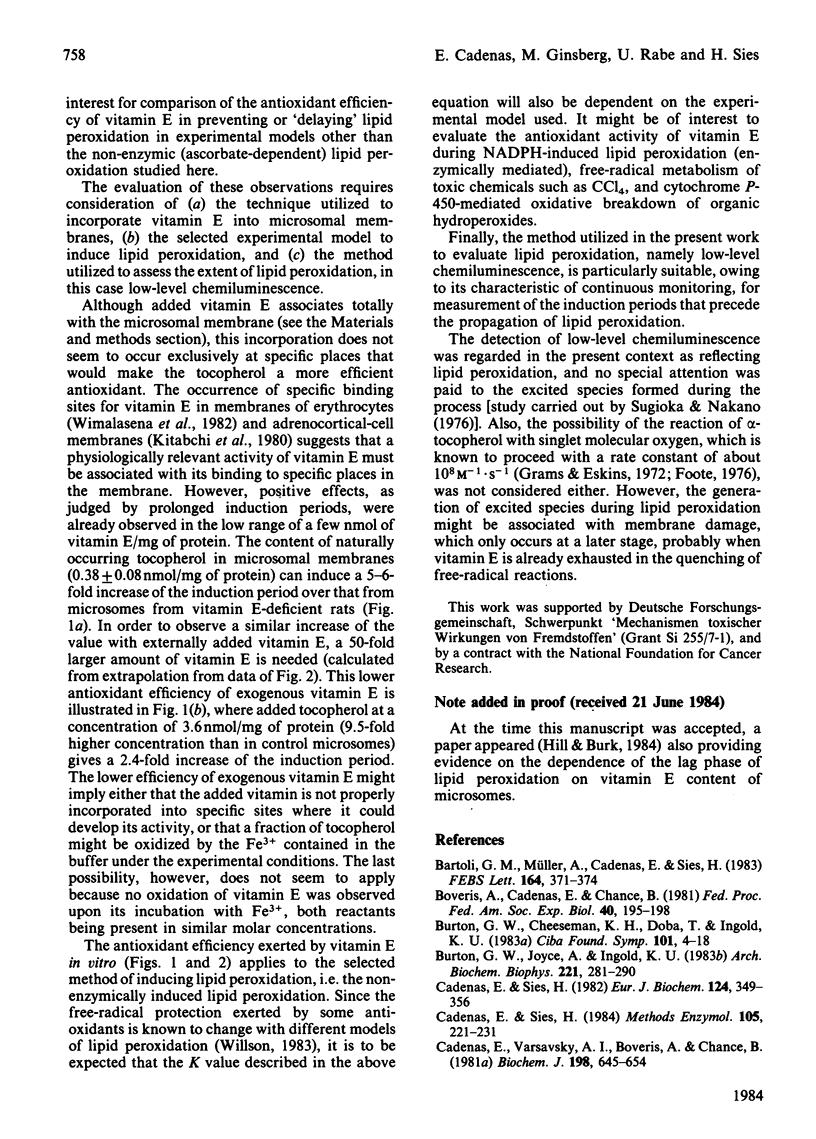
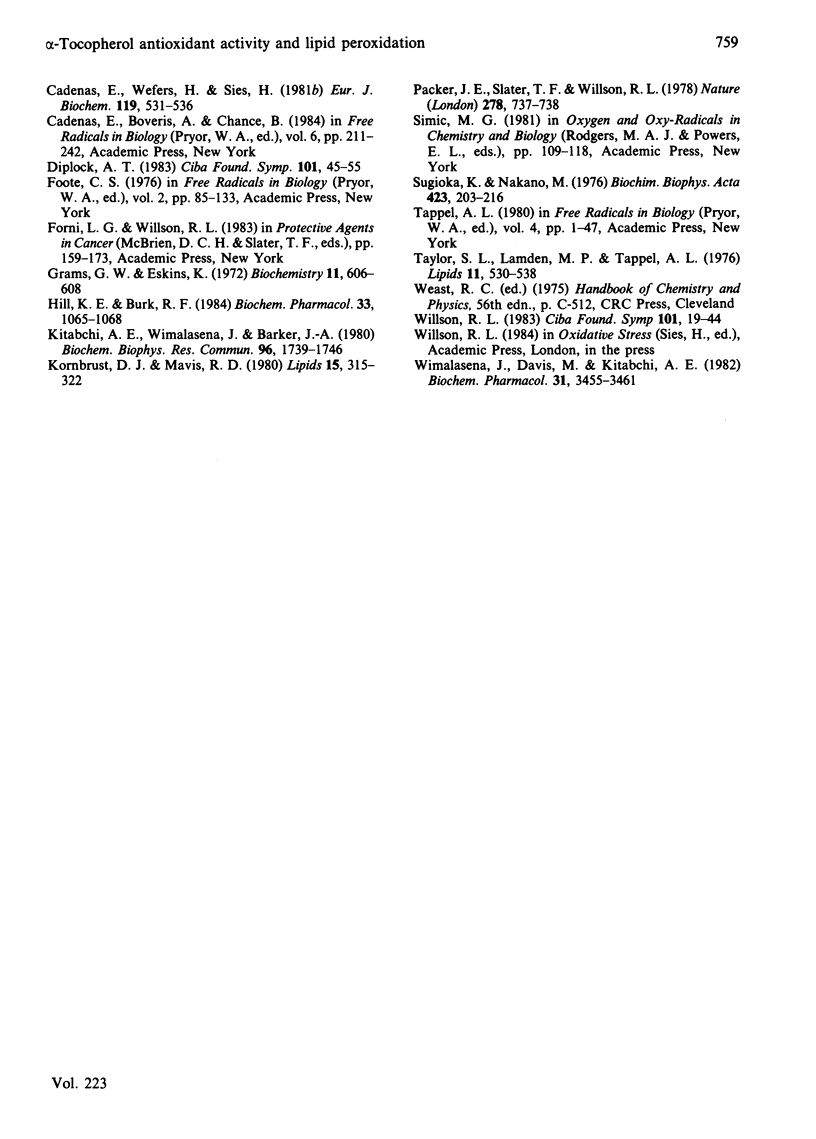
Selected References
These references are in PubMed. This may not be the complete list of references from this article.
- Bartoli G. M., Müller A., Cadenas E., Sies H. Antioxidant effect of diethyldithiocarbamate on microsomal lipid peroxidation assessed by low-level chemiluminescence and alkane production. FEBS Lett. 1983 Dec 12;164(2):371–374. doi: 10.1016/0014-5793(83)80319-6. [DOI] [PubMed] [Google Scholar]
- Boveris A., Cadenas E., Chance B. Ultraweak chemiluminescence: a sensitive assay for oxidative radical reactions. Fed Proc. 1981 Feb;40(2):195–198. [PubMed] [Google Scholar]
- Burton G. W., Cheeseman K. H., Doba T., Ingold K. U., Slater T. F. Vitamin E as an antioxidant in vitro and in vivo. Ciba Found Symp. 1983;101:4–18. doi: 10.1002/9780470720820.ch2. [DOI] [PubMed] [Google Scholar]
- Burton G. W., Joyce A., Ingold K. U. Is vitamin E the only lipid-soluble, chain-breaking antioxidant in human blood plasma and erythrocyte membranes? Arch Biochem Biophys. 1983 Feb 15;221(1):281–290. doi: 10.1016/0003-9861(83)90145-5. [DOI] [PubMed] [Google Scholar]
- Cadenas E., Sies H. Low level chemiluminescence of liver microsomal fractions initiated by tert-butyl hydroperoxide. Relation to microsomal hemoproteins, oxygen dependence, and lipid peroxidation. Eur J Biochem. 1982 May 17;124(2):349–356. doi: 10.1111/j.1432-1033.1982.tb06599.x. [DOI] [PubMed] [Google Scholar]
- Cadenas E., Sies H. Low-level chemiluminescence as an indicator of singlet molecular oxygen in biological systems. Methods Enzymol. 1984;105:221–231. doi: 10.1016/s0076-6879(84)05029-1. [DOI] [PubMed] [Google Scholar]
- Cadenas E., Varsavsky A. I., Boveris A., Chance B. Oxygen- or organic hydroperoxide-induced chemiluminescence of brain and liver homogenates. Biochem J. 1981 Sep 15;198(3):645–654. doi: 10.1042/bj1980645. [DOI] [PMC free article] [PubMed] [Google Scholar]
- Cadenas E., Wefers H., Sies H. Low-level chemiluminescence of isolated hepatocytes. Eur J Biochem. 1981 Oct;119(3):531–536. doi: 10.1111/j.1432-1033.1981.tb05640.x. [DOI] [PubMed] [Google Scholar]
- Diplock A. T. The role of vitamin E in biological membranes. Ciba Found Symp. 1983;101:45–55. doi: 10.1002/9780470720820.ch4. [DOI] [PubMed] [Google Scholar]
- Grams G. W., Eskins K. Dye-sensitized photooxidation of tocopherols. Correlation between singlet oxygen reactivity and vitamin E activity. Biochemistry. 1972 Feb 15;11(4):606–608. doi: 10.1021/bi00754a020. [DOI] [PubMed] [Google Scholar]
- Hill K. E., Burk R. F. Influence of vitamin E and selenium on glutathione-dependent protection against microsomal lipid peroxidation. Biochem Pharmacol. 1984 Apr 1;33(7):1065–1068. doi: 10.1016/0006-2952(84)90514-8. [DOI] [PubMed] [Google Scholar]
- Kitabchi A. E., Wimalasena J., Barker J. Specific receptor sites for alpha-tocopherol in purified isolated adrenocortical cell membrane. Biochem Biophys Res Commun. 1980 Oct 31;96(4):1739–1746. doi: 10.1016/0006-291x(80)91375-3. [DOI] [PubMed] [Google Scholar]
- Kornbrust D. J., Mavis R. D. Relative susceptibility of microsomes from lung, heart, liver, kidney, brain and testes to lipid peroxidation: correlation with vitamin E content. Lipids. 1980 May;15(5):315–322. doi: 10.1007/BF02533546. [DOI] [PubMed] [Google Scholar]
- Packer J. E., Slater T. F., Willson R. L. Direct observation of a free radical interaction between vitamin E and vitamin C. Nature. 1979 Apr 19;278(5706):737–738. doi: 10.1038/278737a0. [DOI] [PubMed] [Google Scholar]
- Sugioka K., Nakano M. A possible mechanism of the generation of singlet molecular oxygen in nadph-dependent microsomal lipid peroxidation. Biochim Biophys Acta. 1976 Feb 16;423(2):203–216. doi: 10.1016/0005-2728(76)90179-1. [DOI] [PubMed] [Google Scholar]
- Taylor S. L., Lamden M. P., Tappel A. L. Sensitive fluorometric method for tissue tocopherol analysis. Lipids. 1976 Jul;11(7):530–538. doi: 10.1007/BF02532898. [DOI] [PubMed] [Google Scholar]
- Willson R. L. Free radical protection: why vitamin E, not vitamin C, beta-carotene or glutathione? Ciba Found Symp. 1983;101:19–44. [PubMed] [Google Scholar]
- Wimalasena J., Davis M., Kitabchi A. E. Characterization and solubilization of the specific binding sites for d-alpha-tocopherol from human erythrocyte membranes. Biochem Pharmacol. 1982 Nov 1;31(21):3455–3461. doi: 10.1016/0006-2952(82)90626-8. [DOI] [PubMed] [Google Scholar]


